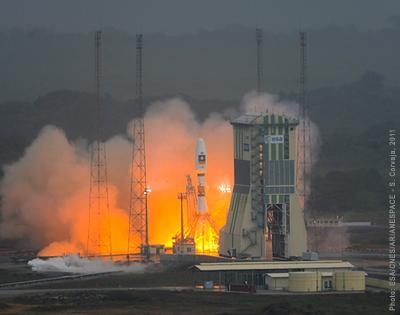Sat, Oct 22, 2011
Arianespace Places Two Satellites In Orbit Aboard Russian-Built
Launch Vehicle
The first Soyuz launch vehicle to lift off from Arianespace's
facility in French Guiana successfully placed Europe’s first
two Galileo navigation satellites into orbit Friday. Lifting off
from the ELS launch site in the Spaceport’s northwestern
sector, Soyuz performed a 3-hour 49-minute flight to inject its two
Galileo In-Orbit Validation (IOV) spacecraft into a 23,222-km.
circular medium-Earth orbit, inclined 54.7 degrees.

With Friday's nominal launch, Soyuz
enters Arianespace’s growing launcher family –
providing a medium-lift vehicle operating at the Spaceport
alongside the heavy-lift Ariane 5, and to be joined in 2012 by the
lightweight Vega at French Guiana.
Soyuz has served as the launch vehicle for manned and unmanned
missions from its long-operating launch bases at Baikonur
Cosmodrome in Kazakhstan, and Russia’s Plesetsk Cosmodrome.
The maiden flight from its new “home” at the Spaceport
marked Soyuz’ 1,777th launch, and began at 0730:26 local time
in French Guiana – enabling the Galileo satellites’
injection into their proper orbital plane.
Arianespace Chairman & CEO Jean-Yves Le Gall noted that Soyuz
already has become a commercial success, with 14 firm payload
contracts booked for missions with this medium-lift vehicle from
the Spaceport – all signed prior to today’s inaugural
flight. He recognized the determined efforts of those who advanced
the Soyuz at French Guiana project from its first studies in the
late 1990s to a successful introduction today – stating that
the project’s key players are true space visionaries.
“Bravo Europe…bravo Russia…bravo
cooperation,” Le Gall added during comments made at the
Spaceport’s Jupiter mission control center.

Compared to other Soyuz launchers, the version used by
Arianespace at the Spaceport incorporates a new digital control
system that increases flight authority during the launcher’s
atmospheric ascent, and enables the use of an enlarged ST-type
payload fairing for greater flexibility in accommodating spacecraft
passengers.
It also is equipped with the Fregat upper stage, which is designed
as an autonomous orbital vehicle and has the capability to be
restarted up to 20 times in flight – enabling complex payload
deployment profiles to be performed. (Images courtesy
Arianespace)
More News
Light Gun A handheld directional light signaling device which emits a brilliant narrow beam of white, green, or red light as selected by the tower controller. The color and type of>[...]
"The journey to this achievement started nearly a decade ago when a freshly commissioned Gentry, driven by a fascination with new technologies and a desire to contribute significan>[...]
Aero Linx: JAARS, Inc. For decades now, we’ve landed planes on narrow rivers and towering mountains. We’ve outfitted boats and vehicles to reach villages that rarely se>[...]
"Our driven and innovative team of military and civilian Airmen delivers combat power daily, ensuring our nation is ready today and tomorrow." Source: General Duke Richardson, AFMC>[...]
Aircraft Conflict Predicted conflict, within EDST of two aircraft, or between aircraft and airspace. A Red alert is used for conflicts when the predicted minimum separation is 5 na>[...]
 ANN's Daily Aero-Term (04.20.24): Light Gun
ANN's Daily Aero-Term (04.20.24): Light Gun Aero-News: Quote of the Day (04.20.24)
Aero-News: Quote of the Day (04.20.24) ANN's Daily Aero-Linx (04.21.24)
ANN's Daily Aero-Linx (04.21.24) Aero-News: Quote of the Day (04.21.24)
Aero-News: Quote of the Day (04.21.24) ANN's Daily Aero-Term (04.21.24): Aircraft Conflict
ANN's Daily Aero-Term (04.21.24): Aircraft Conflict




